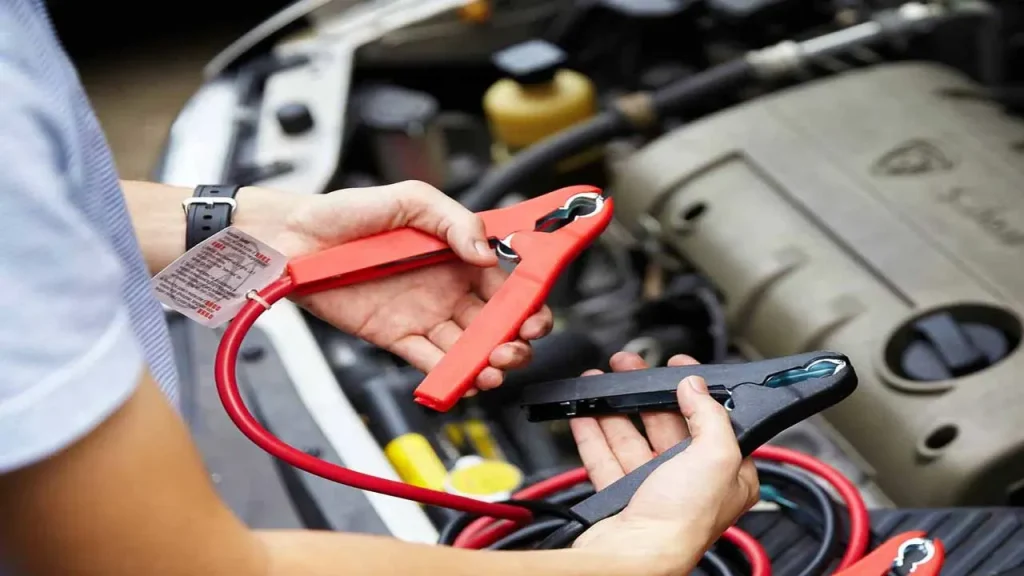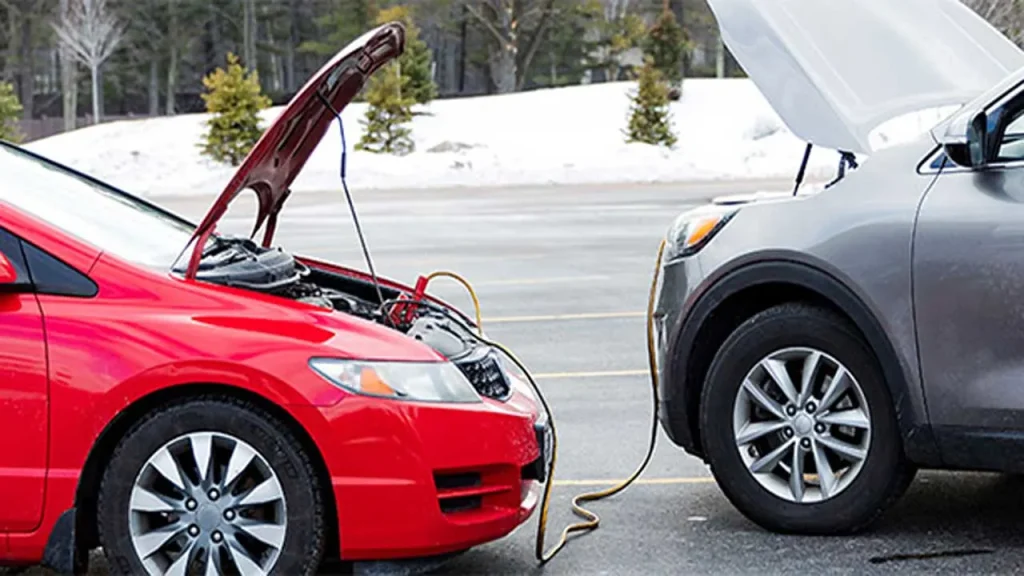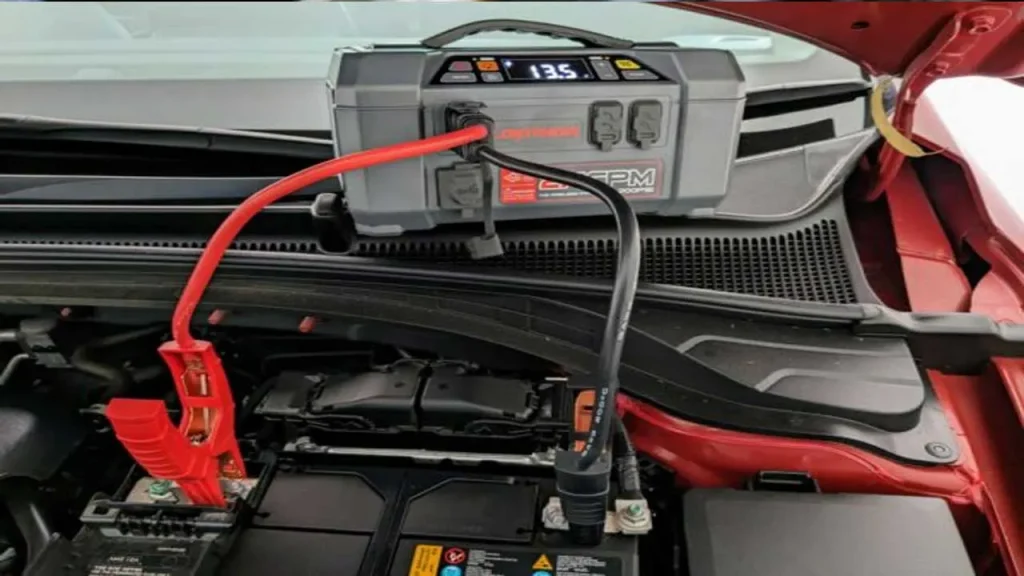Jumping a Car Like a Pro Step-by-Step Guide & Safety Tips

I have spent years helping drivers get back on the road, and one lesson I have learned is that a dead car battery never happens at a convenient time. Whether you are late for work, stuck in a parking lot, or far from home, that sudden silence when you turn the key can feel like a punch to the gut. The good news is that jumping a car battery is easier than most people think, and with the right steps, you can do it safely and confidently.
In this guide, I will share exactly what you need before jumping a car, the safest way to connect and remove cables, how to jumpstart a dead battery without another car, and simple habits to prevent it from dying in the future. By the end, you will not just know how to jumpstart a car, you will be ready to handle it like a pro anytime, anywhere.
What You Need Before Jumping a Car

Jumper cables
A good set of jumper cables is the most important tool for jumping a car. Choose cables that are at least ten to twelve feet long so they can easily reach between two vehicles parked close but not touching. Thicker cables with strong clamps work better because they can transfer power faster and more safely. Keeping them in your trunk at all times means you will always be prepared in case your battery dies unexpectedly.
A working vehicle with a charged battery
You will need another vehicle with a battery that is in good condition and fully charged. This vehicle will supply the necessary power to start the one with the dead battery. Make sure the working car is parked close enough for the cables to reach but far enough to avoid any accidental contact between the vehicles. If you can, choose a vehicle with a similar battery size to get the best results.
Gloves and safety glasses

Wearing gloves can protect your hands from grease dirt and accidental sparks during the process. Safety glasses are useful because old or damaged batteries can sometimes leak or release small amounts of fluid when being jump started. Having this simple protective gear can help you stay safe and confident while working near the battery.
A safe parking spot
Both cars should be parked in a safe open space away from busy roads or moving traffic. Choose a flat well lit area so you can clearly see the battery terminals and cable connections. Avoid jump starting in wet conditions if possible because water can make surfaces slippery and increase the risk of electrical hazards. Having all these items ready before you start makes the process smoother reduces stress and helps you get your car running again quickly.
How Long Does Jumping a Car Take
The time it takes to jumping a car depends on the method you use and the battery’s condition. In most cases, the actual process of connecting the cables or a jump starter takes just a couple of minutes. If you are using another vehicle, it typically takes 2–5 minutes of the working car running to give the dead battery enough charge to start. For severely drained batteries, you may need to wait up to 10 minutes before trying.
With a portable jump starter, the process is often quicker; you can usually attempt starting the car immediately after connecting the clamps. Once the engine starts, let it run for 15–20 minutes or take a short drive so the alternator can recharge the battery. Skipping this step may leave you with another dead battery the next time you try to start the car.
Safety Tips Before You Start
- Park in a flat safe place away from traffic so you have space to work and can move around the car without risk from passing vehicles.
- Turn off the engine on both vehicles before attaching cables to prevent sudden power surges that can damage the electrical system.
- Check batteries for cracks, leaks or swelling because damaged batteries can leak acid or even explode if jumpstarted.
- Keep tools and metal away from the battery since metal touching the terminals can cause sparks or dangerous short circuits.
- Read the manual of a portable jump starter so you know the correct connection steps and safety precautions for your specific model.
- Wear gloves and safety glasses to protect your hands from dirt or sparks and your eyes from battery acid or debris
Step-by-Step Ways to Jump start a Car With or Without Help

Jumpstarting with another vehicle
- Park the two cars close together but make sure they are not touching. This allows the cables to reach without creating a safety risk.
- Turn off both engines before attaching any cables to avoid electrical surges.
- Open the hoods and locate each battery. Identify the positive terminal marked with a plus sign or red cover and the negative terminal marked with a minus sign.
- Attach one end of the red clamp to the positive terminal of the dead battery, then connect the other red clamp to the positive terminal of the charged battery.
- Connect the black clamp to the negative terminal of the charged battery. Attach the last black clamp to an unpainted metal part of the car with the dead battery to prevent sparks.
- Start the working car first and let it run for a couple of minutes to send power to the dead battery.
- Try starting the car with the dead battery. If it starts, let it idle for a few moments before removing the cables.
- Remove the clamps in the reverse order they were connected, starting with the black clamp on the metal surface, then the black clamp on the charged battery, and finally the two red clamps.
- Keep the car running for fifteen to twenty minutes or take it for a short drive so the alternator can recharge the battery.
How to Jumpstart a Dead Battery Without Another Car
If you do not have another vehicle available, you can still start your car using a portable jump starter. These devices store enough power to boost a dead battery on their own. First, park the car in a safe, level spot and switch off the engine. Open the hood and locate the battery, identifying the positive terminal (marked with a plus sign or red cover) and a clean, unpainted metal part of the engine.
Connect the red clamp from the jump starter to the positive terminal, then connect the black clamp to the metal surface rather than the battery’s negative terminal to reduce the risk of sparks. Switch on the jump starter and try starting the car. Once the engine is running, turn off the jump starter and remove the clamps in reverse order black first, then red. Let the car run for fifteen to twenty minutes or take a short drive to recharge the battery fully.
Jumpstarting by yourself with a portable jump starter

- Park your car in a safe and level spot, away from traffic, and turn off the engine.
- Open the hood and locate the battery. Identify the positive terminal marked with a plus sign or red cover and the negative terminal marked with a minus sign.
- Connect the red clamp from the jump starter to the positive terminal of the battery.
- Connect the black clamp to a clean, unpainted metal surface on the engine block rather than the negative terminal to avoid sparks.
- Turn on the jump starter and then try starting your car.
- If the car starts, let it idle briefly before disconnecting the jump starter.
- Remove the clamps in reverse order: black clamp first, then red clamp.
- Turn off the jump starter and store it safely.
- Keep the engine running for fifteen to twenty minutes or take the car for a short drive to recharge the battery.
When Jumping a Car Which Cable Comes Off First
After the car starts and is running smoothly, the cables need to be removed in the correct order to avoid sparks and protect the vehicle’s electrical system. Always remove the black clamp first, which is connected to the negative terminal or a grounded metal part. This step cuts the connection to the electrical ground and reduces the chance of an accidental short circuit. Once the black clamp is off, remove the red clamp from the positive terminal. Keeping this order not only makes the process safer but also helps prevent damage to sensitive electronics in modern vehicles.
Common Mistakes to Avoid While Jumpstarting a Car
- Connecting the clamps in the wrong order
Always connect the red clamp to the positive terminal first and the black clamp to a safe unpainted metal surface last. Reversing this order can create sudden sparks which may damage the battery or electrical system. Following the correct order also helps protect you from electric shock and makes the process smoother. - Placing the black clamp on the negative terminal
Avoid attaching the black clamp directly to the negative terminal of the dead battery. Doing this can cause sparks very close to the battery where flammable gases may be present. A better option is to connect it to a clean metal part of the engine block or chassis which is safer and still completes the electrical circuit. - Using damaged or poor quality jumper cables
Thin worn or frayed cables cannot carry enough power to start the car and may even overheat or melt during use. Choose thick heavy duty cables with strong clamps that grip tightly onto the battery terminals. This ensures a stronger power flow and reduces the risk of accidents. - Trying to jumpstart with a weak or dead second battery
If the battery in the assisting car or portable jump starter is weak you will not have enough power to start your car. A low battery can also get drained completely in the process leaving both cars unable to start. Always check that the assisting battery is fully charged before beginning. - Skipping safety checks
Jumpstarting a cracked leaking or swollen battery is risky because it can lead to explosions or harmful acid leaks. Take a moment to inspect the battery before connecting anything. If you see any damage call for roadside assistance instead of attempting the jump yourself. - Not letting the engine run after a successful jump
Switching off the car right after it starts can cause the battery to lose charge again almost immediately. Let the engine run for at least fifteen to twenty minutes or drive the car around to help the alternator recharge the battery properly. This step reduces the chance of the car stalling later..
After the Car Starts
Once your car is running again, it is important to give the battery enough time to recharge. Keep the engine running for at least fifteen to twenty minutes or, even better, take the car for a short drive. Driving helps the alternator work more effectively than idling and restores the battery’s power faster.
During this time, avoid turning off the engine or using high-power electrical accessories such as the air conditioner or heated seats, as these can put extra strain on a weak battery. Pay attention to how the car behaves if it starts smoothly the next time, your battery likely just needed a boost. If it struggles again, the battery may be too old or damaged to hold a charge, and replacing it will be the safest choice.
When Jumping a Car Doesn’t Work
Sometimes, even after following every step correctly, your car still will not start. This can be frustrating, but its common causes can help you decide your next move.
Dead or failing alternator
The alternator is what keeps your battery charged while the engine runs. If it fails, your battery will drain quickly even after a jumpstart. In some cases, the car might start but then shut off again after a short time because the alternator is not supplying power. You may also notice flickering lights, unusual noises from the engine bay, or the battery warning light glowing on the dashboard.
Worn-out battery
Most car batteries have a lifespan of about three to five years, but extreme temperatures, short trips, and heavy electrical use can shorten that life. A battery that is too old may not hold any charge, no matter how many times you try to jump it. Signs include slow cranking, dim headlights, and the need for frequent jumpstarts. Replacing it with a fresh battery is often the only solution.
Faulty starter motor or ignition system
If the starter motor is faulty, it will not be able to turn the engine over even with a fully charged battery. This often shows up as a loud click or a rapid series of clicks when you try to start the car. Problems in the ignition system, such as a worn ignition switch, can also prevent the engine from starting at all. These issues usually require professional repair or replacement parts.
Loose or corroded battery connections
Even if the battery and alternator are working, poor connections can stop the flow of power. Corrosion appears as a white, green, or blue powder around the battery terminals and can interrupt the electrical contact. Loose clamps can cause similar issues. Cleaning the terminals with a wire brush and tightening the clamps can sometimes get your car running again without more serious repairs.usually means there is a deeper issue that a simple jumpstart cannot fix.
(If your car still will not start after a jump, it is best to contact a mechanic or roadside assistance. They can run diagnostic tests on the battery, alternator, starter motor, and wiring to pinpoint the issue and prevent more costly breakdowns later.)
Why Is My Car Battery Dead
A dead car battery is usually caused by specific issues rather than bad luck. Batteries lose power when exposed to extreme temperatures, left unused for long periods, or when electronics are left running with the engine off. Over time, normal wear also reduces their ability to hold a charge, making them more likely to fail. Identifying the cause helps you prevent it from happening again.
Common Causes of Car Battery Failure
A car battery can fail for several reasons, and in many cases, more than one factor may be at play. Understanding these causes can help you spot early warning signs and prevent unexpected breakdowns.

- Leaving headlights, interior lights, or electronics on when the engine is off drains the stored power, sometimes overnight. Even a phone charger left plugged in can slowly weaken the battery.
- Extreme cold slows down the chemical reactions inside the battery, making it harder to produce the power needed to start the engine.
- Extreme heat can evaporate the internal fluid, damaging the plates and reducing the battery’s lifespan.
- Infrequent driving or short trips do not give the alternator enough time to recharge the battery fully, causing it to weaken over time.
- Natural aging happens to every battery, and after three to five years, most will struggle to hold a charge.
- Faulty charging system components, such as a failing alternator or voltage regulator, prevent the battery from receiving a full charge.
- Loose or corroded battery connections disrupt the flow of electricity, even if the battery itself is healthy.
Preventing a Dead Battery in the Future
Taking a few simple steps can greatly reduce the chances of your battery dying unexpectedly. Good habits and regular checks not only extend battery life but also save you from the stress of being stranded.
Drive your car regularly
Short trips and long periods of inactivity slowly drain the battery because the alternator does not have enough time to recharge it fully. Try to take your car for a drive lasting at least 20–30 minutes a few times a week. If you know you will not be using the car for a while, consider using a battery maintainer to keep it charged.
Turn off electronics when the engine is off
Leaving lights, the radio, or charging devices plugged in when the engine is not running will drain the battery faster than you think. Make it a habit to do a quick check before leaving the car to ensure all electronics are turned off. This small step can save you from waking up to a dead battery.
Keep the battery clean and secure
Corrosion can form on the battery terminals over time, creating poor connections and reducing the battery’s ability to send power to jumping a car. Inspect the battery regularly and clean off any build up with a wire brush and a mix of baking soda and water. Also, make sure the battery is firmly secured in its tray to prevent vibrations that can damage internal components.
Service your car on schedule
Regular servicing not only helps the engine run smoothly but also ensures the battery and charging system are in good condition. During maintenance, ask the mechanic to test the battery’s health and check that the alternator is working properly. Spotting problems early can prevent unexpected breakdowns.
Replace the battery before it fails
Even a well-maintained battery has a limited lifespan, usually around three to five years. After this period, the risk of sudden failure increases. Keep track of the installation date and replace the battery before it shows serious signs of weakness, such as slow cranking or frequent jumpstarts.
Conclusion
Jumping a car is not as complicated as it may seem, and now you have the knowledge to do it safely and confidently. From gathering the right tools to following each step in the correct order, you can bring a dead battery back to life whether you have help from another vehicle or use a portable jump starter.
You have also learned what to check if jumping a car does not work, the common causes of battery failure, and the simple habits that can prevent it from happening again. The next time you are faced with a dead battery, you will know exactly how to respond without stress. Keep your battery maintained, drive regularly, and replace it before it fails. With these tips, jumping a car becomes a skill you can rely on to keep your day and your journey moving forward.
